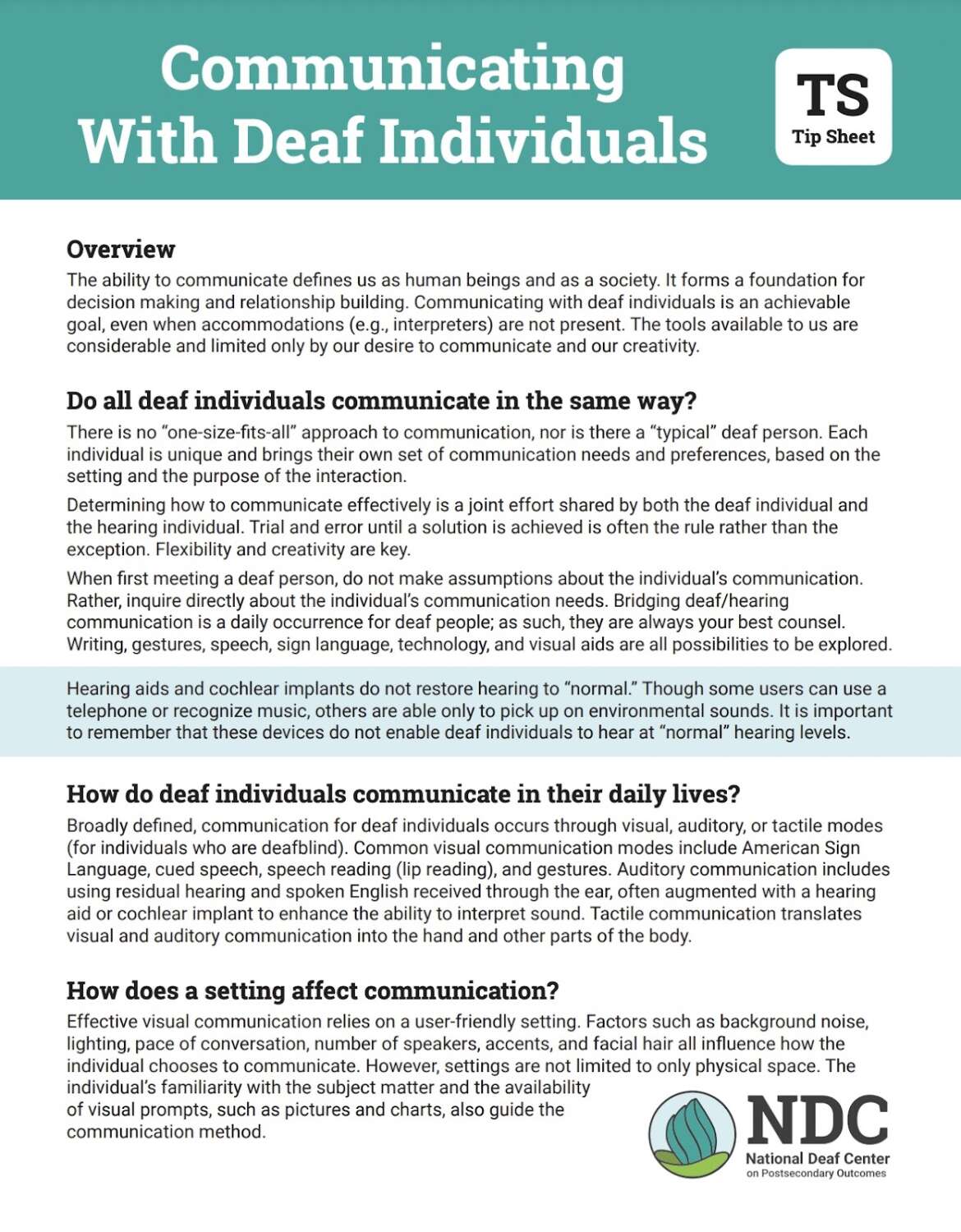Overview
The ability to communicate defines us as human beings and as a society. It forms a foundation for decision making and relationship building. Communicating with deaf people is an achievable goal, even when accommodations (e.g., interpreters) are not present. The tools available to us are considerable and limited only by our desire to communicate and our creativity.
Do all deaf people communicate in the same way?
There is no “one-size-fits-all” approach to communication, nor is there a “typical” deaf person. Each individual is unique and brings their own set of communication needs and preferences, based on the setting and the purpose of the interaction.
Determining how to communicate effectively is a joint effort shared by both the deaf individual and the hearing individual. Trial and error until a solution is achieved is often the rule rather than the exception. Flexibility and creativity are key.
When first meeting a deaf person, do not make assumptions about the individual’s communication. Rather, inquire directly about the individual’s communication needs. Bridging deaf/hearing communication is a daily occurrence for deaf people; as such, they are always your best counsel. Writing, gestures, speech, sign language, technology, and visual aids are all possibilities to be explored.
Hearing aids and cochlear implants do not restore hearing to “normal.” Though some users can use a telephone or recognize music, others are able only to pick up on environmental sounds. It is important to remember that these devices do not enable deaf people to hear at “normal” hearing levels.
How do deaf people communicate in their daily lives?
Broadly defined, communication for deaf people occurs through visual, auditory, or tactile modes (for people who are deafblind). Common visual communication modes include American Sign Language, cued speech, speech reading (lip reading), and gestures. Auditory communication includes using residual hearing and spoken English received through the ear, often augmented with a hearing aid or cochlear implant to enhance the ability to interpret sound. Tactile communication translates visual and auditory communication into the hand and other parts of the body.
How does a setting affect communication?
Effective visual communication relies on a user-friendly setting. Factors such as background noise, lighting, pace of conversation, number of speakers, accents, and facial hair all influence how the individual chooses to communicate. However, settings are not limited to only physical space. The individual’s familiarity with the subject matter and the availability of visual prompts, such as pictures and charts, also guide the communication method.
Tips for Communicating
- Get the attention of the deaf individual before speaking. If the individual does not respond to the spoken name, a tap on shoulder or another visual signal is appropriate.
- Provide a written outline of the main topics to be discussed. This is especially helpful for people who depend on speech reading to pick up on keywords in a conversation.
- Speak clearly and at a normal pace; do not yell or over-enunciate.
- Look directly at the individual while speaking.
- Do not cover your mouth or look around while speaking.
- Avoid standing in front of a light source, which can make it difficult to see your face clearly.
- If you need to repeat, rephrase the thought. Some words are harder to understand than others; rephrasing allows for opportunities to understand what was previously missed.
- Use visual aids, gestures, and body language when appropriate. The old saying that “one picture is worth a thousand words” is very true.
- Do not be afraid to use pen and pencil or texting as a tool.
- Use open-ended questions to allow for more opportunities for both parties to check each other’s understanding of a topic.
Only about 30% of English speech sounds are visible on the mouth under the best of conditions. Factors that can affect speechreading include residual hearing, body language and facial expressions, distance from the speaker, and awareness of the topic under discussion. Communication or conversations may be easier one-on-one in a quiet setting but more difficult in a group or in a noisy environment.
How can I enhance communication in large-group situations?
- Use name tags for group interactions with unfamiliar people. It is much easier to associate a name to a face when it’s readily available to the eye.
- In group meetings, establish turn-taking rules, whereby participants raise their hand before speaking and wait until they are called upon before engaging.
- Allow extra time for one-on-one conversations on new topics.
- Learn a few simple words in sign language, such as please, thank you, and your name. Simple gestures like being willing to communicate in another person’s native language enhance personal and professional relationships.
- Include deaf people in social activities, group events, and “grapevine” news. Some ways to share this information include using written announcements, text messaging, and e-mail.
Related Resources
The Deaf Community: An Introduction.
Additional resources on this subject may be available at www.nationaldeafcenter.org/resources






